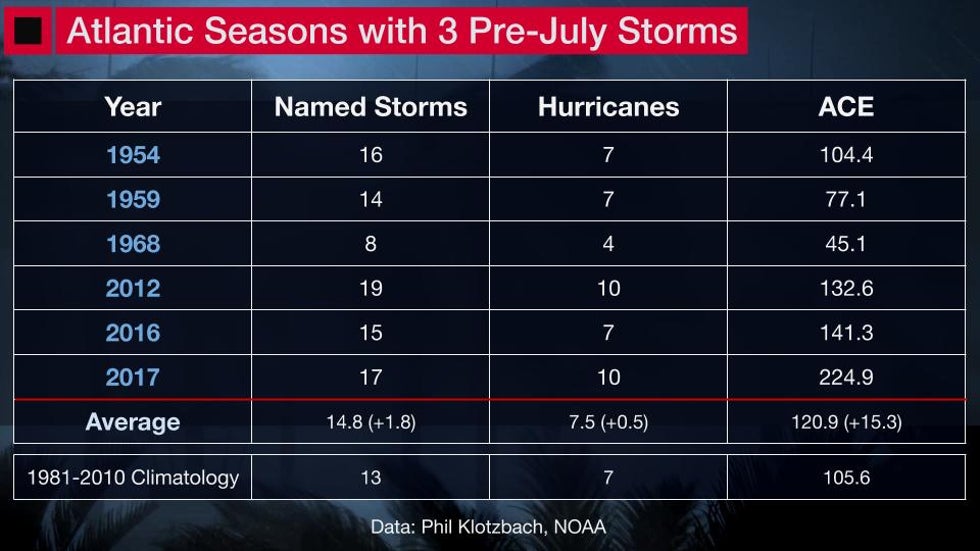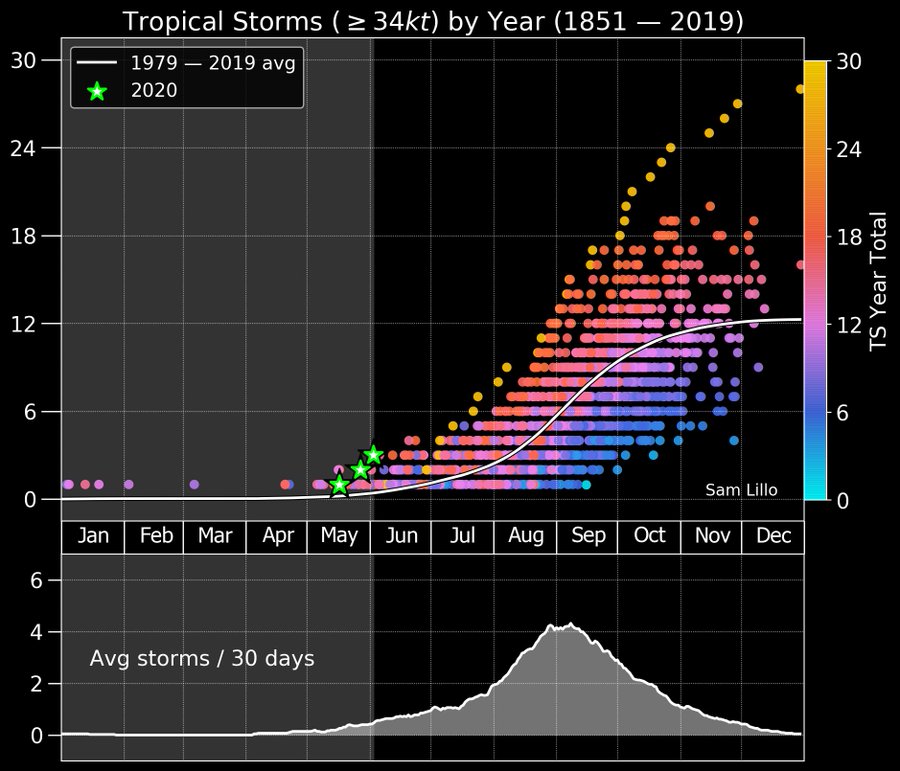With three named tropical storms already in the record books for the 2020 Atlantic hurricane season before mid-June, let's turn the calendar back to see what history can tell us about the rest of hurricane season.
Cristobal's formation came a full two months ahead of the climatological schedule of hurricane season and was the earliest third storm of any season in more than 100 years.
The formation of Tropical Storm #Cristobal — the 3rd Atlantic TS of 2020 — is 62 days ahead of the 1979-2019 average date for the 3rd TS.
Using this third storm as a benchmark, we take a look back at hurricane seasons with at least three named storms by July 1 and found six examples since 1950.
As a group, the numbers of tropical storms and hurricanes were higher than average in these seasons compared to climatology. (Note that three of the seasons occurred prior to the 1981-2010 period used here as climatology.)
 A look back at other hurricane seasons since 1950 where three named storms formed.
A look back at other hurricane seasons since 1950 where three named storms formed.Accumulated Cyclone Energy (or ACE) is a metric that looks at the longevity and intensity of tropical storms and hurricanes rather than simply counting how many occurred.
Long-lived, intense hurricanes have a high ACE index. Short-lived, weak tropical storms, a low ACE index. The ACE of a hurricane season is the sum of each storm's ACE, thus taking into account the number, strength and duration of all the tropical storms or hurricanes in the season.
Half of the six seasons in the table above had an above-average ACE index. One season had average activity, and two seasons were relatively quiet. Thus, it seems that an active early season means a busy season overall is more possible, but is not a guarantee.
One other, perhaps, more important metric to determine if a season was active or not was how many storms made landfall in the United States.
In those six seasons, an average of 5.8 tropical cyclones – tropical depressions, tropical storms and hurricanes – made landfall in the Lower 48. In three seasons – 1954, 1959 and 1968 – seven cyclones made landfall in each of those seasons. This means that roughly half of all cyclones that became at least tropical storms in their lifetime in those seasons made landfall.
So far, we've had two U.S.-landfalling storms, with Bertha moving inland across the Carolinas and Cristobal riding the Mississippi River northward recently.
 Seasonal Track Maps for Six Years With Active Starts
Seasonal Track Maps for Six Years With Active StartsBut this may entirely be coincidental.
These six years are only a very small dataset for known hurricane seasons going back to the 1850s. Some years become less active later in the season, while others become more active.
Overall, there is no correlation between the number of storms and the number of landfalls in a season.
Phil Klotzbach of Colorado State University notes 96 percent of Category 3 or stronger continental U.S. hurricane landfalls have occurred between August and October.
Of course, it is possible that we either have a lackluster remainder to the season, with fewer storms, or we have no more landfalling systems going forward, but this seems especially optimistic given the data presented here and the forecast.
The Weather Company and Colorado State University continue to forecast a well-above-average hurricane season going forward.
So this is the time to develop or review your hurricane plan, well before a storm or hurricane is on the horizon.
The Weather Company’s primary journalistic mission is to report on breaking weather news, the environment and the importance of science to our lives. This story does not necessarily represent the position of our parent company, IBM.
The Weather Company’s primary journalistic mission is to report on breaking weather news, the environment and the importance of science to our lives. This story does not necessarily represent the position of our parent company, IBM.



No comments:
Post a Comment